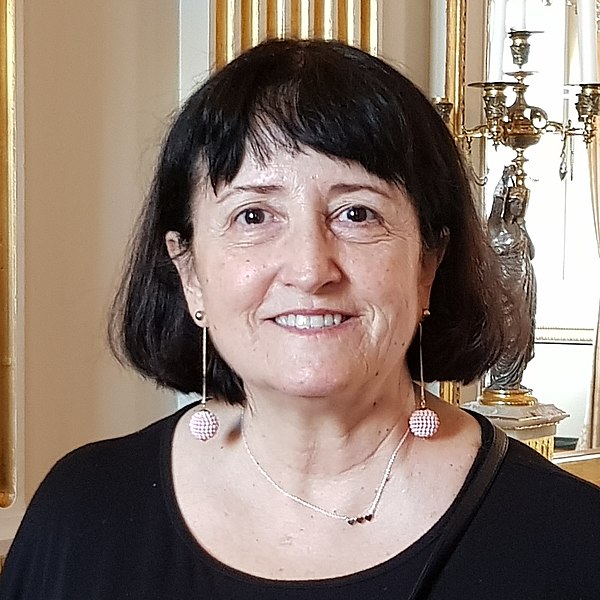
How started this big love between Rosie and Wikipedia?
In June 2007, I was visiting my son Sean in San Francisco. While there, I was on my computer, and I googled a book publisher whose books I collect (I’m a bibliophile): Book League of America. But I couldn’t find a Wikipedia article about it. I thought I made a spelling mistake or maybe my capitalization of the name had errors, because, I thought, „Wikipedia has an article about everything!“. After a few minutes, I realized there was no problem with my spelling or capitalization of the name… there just wasn’t an article about it. At that point, I remembered that Sean had edited Wikipedia when he was in the Peace Corps, living in Ukraine, and it made me think, „Well, if Sean can figure out how to edit Wikipedia, I bet I can, too.“ So I created the article for Book League of America (https://en.wikipedia.org/
Please, tell us more about Women in Red – your great project.
Between 2007 and 2014, I created thousands of articles about all sorts of topics. I wrote a considered amount of anthroponymy articles (the study of names); then articles about geographic places of Nunavut, Canada; and then towns in Asturias, Spain. In 2012-14, to celebrate Women’s History Month during the month of March, many editors, including me, stopped writing articles about other topics and only focused on women’s biographies. We could tell that there were fewer biographies about women than men when we looked at category pages, but there were no statistics at the time regarding percentages. In December 2014, I saw for the first time an academic article regarding women’s biographies on Wikipedia, and it said that approximately 15% of the biographies were about women. In February 2015, Roger Bamkin (user:Victuallers) left a message on my talkpage saying he wanted to write up a session proposal for Wikimania 2015 regarding the small percentage of women’s biographies, and he invited me to do this with him, which I gladly did. After our submission (https://wikimania2015.
How people, reading this interview, can participate and be part of Women in Red?
There are several different ways!
- Create a Women in Red page on Bulgarian Wikipedia and link it on Wikidata (https://www.wikidata.org/
wiki/Q23875215) - See which events English Wikipedia Women in Red is facilitating each month by subscribing to our monthly invitation (https://en.wikipedia.org/
wiki/Wikipedia:WikiProject_ Women_in_Red/Outreach/List) and facilitate them (online or in-person) in Bulgarian language - If you tweet about a woman’s biography (in Bulgarian or any other language), and if you include @wikiwomeninred in the tweet, we will retweet it.
- Suggest future editathons at our Ideas Cafe (https://en.wikipedia.org/
wiki/Wikipedia:WikiProject_ Women_in_Red/Ideas) - Add the category for Media supported by WikiProject Women in Red 2019 (https://commons.wikimedia.
org/wiki/Category:Media_ supported_by_WikiProject_ Women_in_Red_-_2019) to photos uploaded regarding notable women.
What is the most inspiring thing for you related with Wikimedia?
Wikipedia is transforming. Not only can you affect other people’s lives with what you write, but your life can be changed, too. When I was a young woman, I wanted to be a cultural anthropologist, but my father, who was paying for my university education, said ‘no’ to my majoring in anthropology. He said it wasn’t ‘practical’. So I earned degrees in business, and have had a lovely career in business, but the cultural anthropologist side of me just had to sit and be dormant… that is, until I found I could edit Wikipedia, and write articles about topics which inspire me. In September 2013, an article I created on Goaribari Island (https://en.wikipedia.org/
Some of you know that I am a cultural anthropologist at heart. I wanted to follow in the footsteps of Margaret Mead and study cultural anthropology at Barnard (my mom’s alma mater), like Margaret did. I wanted to travel to Papua New Guinea and do research on its people, like Margaret did. But my dad said ‘no’ to majoring in anthropology – he wanted something more practical for my university studies. So now, years later, I get to live the life of an armchair cultural anthropologist, writing articles about Goaribari Island and its cannibals. To all the girls out there with impractical dreams, this article is dedicated to you.
I was knighted by Serbia in 2018 partly because of my involvement with Wikipedia (e.g. Wikipedian of the Year 2016). So you see, Wikipedia does transform lives.
How Wikipedia makes our societies better and stronger?
The world has always been complicated, but we are more aware of this now because the internet connects us. Wikipedia gives us access to verifiable knowledge, not just in one language, but in more than 300 languages. Society thrives on knowledge. It is the building block to incremental improvements in people’s lives. This makes the Wikimedia movement in general (including Wikidata, WikiCommons, and so forth), and Wikipedia in particular, a fundamental part of a better society. Its strength lies in the fact that „anyone can edit Wikipedia“. While some might see that as an oxymoron, it is, indeed, quite the opposite. So what are you waiting for? Become a Wikipedian today and you will be contributing to a better, stronger society.